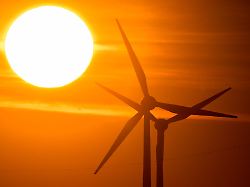Wind and solar power contributed more to the German electricity mix than coal and gas last month. On some days, the yield of renewable energy sources even leads to an excess of energy – and to negative prices.
With the shutdown of the last nuclear reactors in April, electricity production from wind and sun in particular has automatically gained in importance. Current figures from the Federal Network Agency now show that renewable energy sources can definitely fill the gap with the support of pumped storage. According to preliminary calculations by ntv.de, the share of green electricity even reached a new record high last month.
In May, almost 66.4 percent of the electricity generated came from renewable sources. This means that the previous record value from February 2020 was once again clearly exceeded. At that time, the proportion was 61.1 percent. In third place among the months with the highest proportion of green electricity is a strong February, namely from the year 2022. The data goes back to 2015.
The new record from May this year is mainly due to gains in solar energy. A rainy April was followed by a fairly sunny May. As a result, the share of solar power jumped from 15.1 percent in the previous month to a whopping 23.5 percent – that too is a new record.
About a fifth of the total power generation was last obtained from solar energy in the record summer of 2022: June and July 2022 took second and third place in the statistics for solar power records with 20.1 and 19 percent.
Overall, wind farms and solar systems supplied a good 48 percent of the electricity fed into the German power grid in May. Hydropower, biomass, pumped storage and other renewables contributed 18 percent. Coal, natural gas and other conventional energy sources have a monthly share of almost 34 percent.
Electricity from renewable energy sources is not only a climate-friendly, but also a cheap alternative to fossil fuels. On days with a high proportion of green electricity and low electricity demand – for example on public holidays – it is sometimes even possible to switch off observe negative exchange electricity prices, because a surplus of electricity is produced. In such situations, a lack of storage options means that willing buyers benefit from the sell-off. The expansion of the storage infrastructure is therefore one of the core tasks of the energy transition, so that the electricity can be better distributed and become cheaper in the long term.
